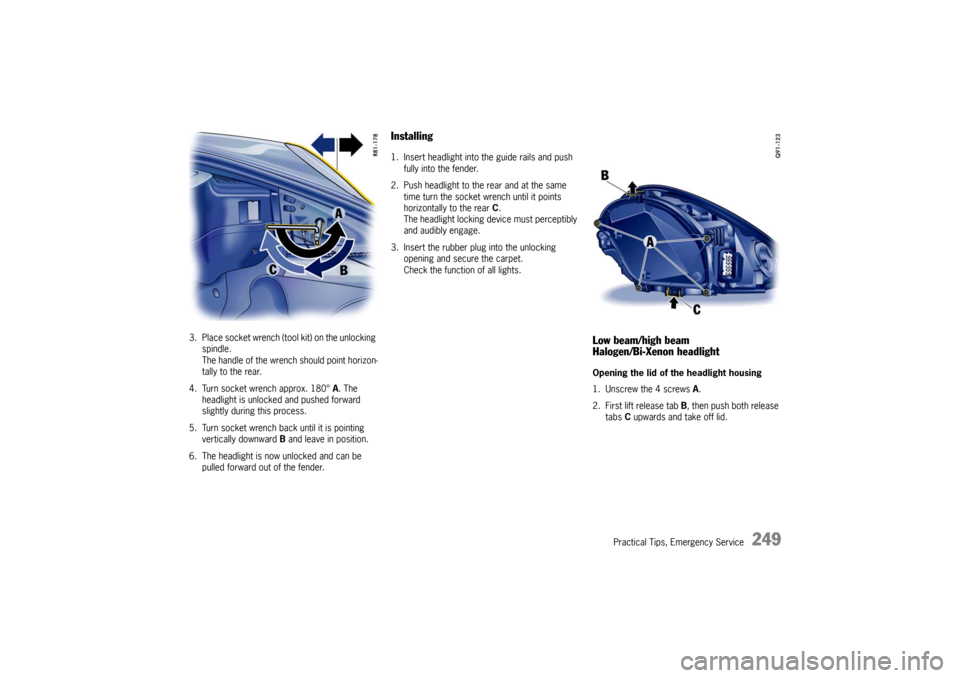Page 238 of 284

236
Practical Tips, Emergency Service
Alarm system, central lockingThe status of the central locking and alarm system
is not changed by disconnecting the battery.
When the battery is di sconnected, the alarm
system ceases to function.Central locking overload protectionIf the central locking sy stem is operated more
than ten times within a minut e, further operation is
blocked for 30 seconds.
Load switch-off after 2 hours or 7 daysIf the ignition key is removed, loads which are
switched on or are in standby mode (such as the
luggage compartment light and interior light) are
automatically switched off after approx. 2hours.
The Radio/PCM is automatically switched off after
approx. 10 minutes.
If the vehicle is not started or unlocked with the
remote control within 7days , the remote control
standby function is switched off (to save the
vehicle battery).
1. In this case, unlock the driver’s door with the key at the door lock.
Leave the door closed in order to prevent the
alarm system from being triggered.
2. Press button 1 on the remote control.
The remote control is now activated again.
Page 239 of 284
Practical Tips, Emergency Service
237
Replacing fuses In order to prevent damage to the electrical sys-
tem due to short circuits and overloads, the indi-
vidual circuits are protected by fuses.
The fuse box is located in the driver’s footwell.
A - Plastic gripper
B - Spare fuses 1. Switch off the load with the defective fuse.
2. Pull off plastic cover at the finger hole (arrow ).
The fuse plan and instructions for
emergency unlocking of the luggage
compartment lid can be found on the inner
side of the cover.
3. Remove the corresponding fuse from its slot using the plastic gripper A in order to check it.
A blown fuse can be ide ntified by the melted
metal strip. 4. Replace only with fuses of the same rating.
We recommend using genuine Porsche fuses
for replacement.
Note
f If a fuse blows repeatedly consult an author-
ized Porsche dealer.
f Never try to “repair” fuses: you may cause se-
rious damage to other pa rts of the electrical
system.
Page 240 of 284

238
Practical Tips, Emergency Service
Emergency unlocking of the front luggage
compartment lidIf the battery is discharged, the front luggage
compartment lid can be opened only with the aid
of a donor battery.
Note
The engine cannot be started with this method.
f Please see the chapter “EMERGENCY
STARTING WITH JUMPER CABLES” on
Page 245.
Unlocking lid
1. Use the key to unlock the vehicle at the door lock.
2. Remove the plastic cover from the fuse box.
3. Pull out positive terminal C (red) in the fuse box
using the plastic gripper A (yellow).
A - Plastic gripper (yellow)
C - Positive terminal (red)4. Use a jumper cable to connect the positive
terminal of the donor battery to the positive
terminal C in the fuse box.
Note
If the vehicle was locked, the alarm horn will sound
when the negative cable is connected.
5. Use the black jumper cable to connect the negative terminal of the donor battery to the
door arrester D.
6. Press button 2 on the remote control for
approx. 2 seconds to unlock the luggage
compartment lid.
The alarm system is switched off.
7. Disconnect the negative cable first, then the positive cable.
8. Push positive terminal C into the fuse box and
push on the plastic fuse box cover.
Page 244 of 284

242
Practical Tips, Emergency Service
Removing the battery The required tool is in the tool kit.
The battery is located in the front luggage com-
partment under a black plastic lid.
Warning!
Risk of damage to alternator and electronic
control units.
f Do not disconnect the battery while the engine
is running.
This also applies to cars equipped with a bat-
tery main switch.
f Never drive the car with a disconnected bat-
tery.
Risk of caustic burns from escaping acid.
f Keep vent caps on to avoid spillage.
f Do not tilt the battery when removing and in-stalling it. 1. Switch off engine and all electrical loads.
2. Open turn-locks
A.
Remove plastic lid.
3. Pull off central vent hose C.
Danger!
Risk of short circuit an d explosion, resulting
in serious personal injury or death.
f Important: disconnect the negative ( –) ground wire first, and then the positive ( +) cable. 4. Important: disconnect the negative (
–) ground
wire first, and then the positive ( +) cable -
danger of short circuit!
5. Unscrew fastening screw B.
6. Remove battery.
Page 245 of 284
Practical Tips, Emergency Service
243
Installing the battery 1. Put battery in and push it all the way to the stop.
2. Screw in fastening screw B .
Danger!
Risk of short circuit and explosion, resulting
in serious personal injury or death.
f Important: connect the positive ( +) cable first, and then the negative ( –) ground wire.
3. Important: connect the positive ( +) cable first,
and then the negative ( –) ground wire -
danger of short circuit!
4. Push on central vent hose C.
Fitting the plastic lid
1. Insert the two outer hooks of the plastic lid into
the eye mounts of the lid opening.
2. Lower the lid.
3. Using both hands, push the lid into the eye mounts without using force (if too much force
is used, the hooks may jam and the panel will
warp).
Make sure that the lid is correctly seated. 4. Turn the turn-locks so
that they point in
longitudinal direction.
5. Press the turn-locks down until they audibly engage.
Page 248 of 284

246
Practical Tips, Emergency Service
Connect jumper cables in the following
sequence: Always observe the sequence below:
1. Connect the positive lead (red) to the
positive terminal of the discharged battery
first, then connect it to th e positive terminal of
the donor battery.
2. First connect the negative cable (black) to
the negative terminal of the donor battery, then
connect it to a suitable grounding point on the
vehicle with the discharged battery.
This grounding point must lie as far as possible
from the battery.
For example, a solid metal part or the engine
block are suitable grounding points.
If no suitable grounding points are to be found
on either vehicle, the negative cable must
carefully be connected directly to the negative
terminal of the battery.
If a suitable grounding point is to be found only
on the donor vehicle, the negative cable must
first be connected to the terminal of the
discharged battery, then to the grounding point
of the donor vehicle.
3. Run the engine of the donor car at a higher speed. 4. Start the engine.
An attempted start using jumper cables should
not last more than 15 seconds. Then allow a
waiting period of at least one minute.
f Note
Before disconnecting the jumper cables, elec-
trical loads such as the heated rear window
and the heating fan blower should be switched
on (the vehicle’s lights must not be switched
on). This reduces voltage peaks which may oc-
cur when disconnecting the jumper cables.
With the engine running, remove both jumper
cables in reverse order.
Page 250 of 284
248
Practical Tips, Emergency Service
Headlights
Caution!
Risk of damage to headlights due to exces-
sive temperatures and abrasion.
f To ensure optimum ventilation, do not cover
the gap between headlight and body
(e.g. “stone guards” or films).
f Use soapy water only to clean light lenses and
plastic headlight lenses.
In no case may chemical cleaners or other vol-
atile cleaning fluids be used.
f To prevent scratches, do not rub with a dry or merely moist cloth, tissue or insect sponges.
Removing headlights1. Unscrew plastic nut A.
Detach the side carpeting. 2. Remove rubber plug
B from the unlocking
opening.
Page 251 of 284

Practical Tips, Emergency Service
249
3. Place socket wrench (tool kit) on the unlocking spindle.
The handle of the wrench should point horizon-
tally to the rear.
4. Turn socket wrench approx. 180° A. The
headlight is unlocked and pushed forward
slightly during this process.
5. Turn socket wrench ba ck until it is pointing
vertically downward B and leave in position.
6. The headlight is now unlocked and can be pulled forward out of the fender.
Installing1. Insert headlight into the guide rails and push
fully into the fender.
2. Push headlight to the rear and at the same time turn the socket wrench until it points
horizontally to the rear C.
The headlight locking device must perceptibly
and audibly engage.
3. Insert the rubber plug into the unlocking opening and secure the carpet.
Check the function of all lights.
Low beam/high beam
Halogen/Bi-Xenon headlightOpening the lid of the headlight housing
1. Unscrew the 4 screws A .
2. First lift release tab B, then push both release
tabs C upwards and take off lid.